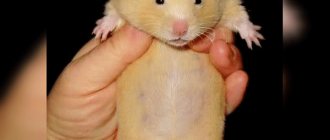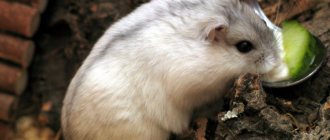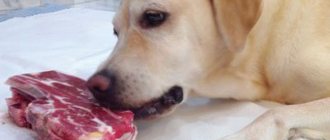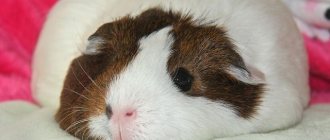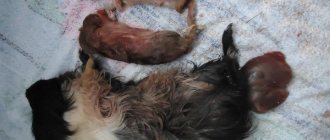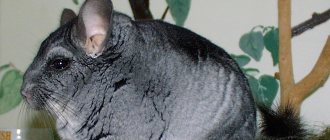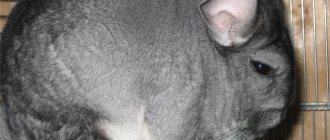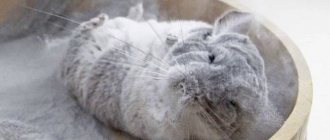This article will talk about breeding chinchillas at home and the rules for giving birth.
On the one hand, this is a profitable business that does not require large upfront costs, on the other hand, it is an exciting hobby. Indeed, today these animals are considered not only as a source of valuable fur, but also as pets, which are often bought for city apartments or private houses. But before breeding chinchillas, you should familiarize yourself with special literature, study the features of their maintenance, breeding, raising young animals and take care of creating the necessary conditions.
To breed chinchillas, do you need to create the right conditions and choose a pet?
Your first task in order to breed chinchillas is to choose and equip the right room for chinchillas!
Important: The volume of your business directly depends on the area that you are willing to allocate for keeping chinchillas. The minimum cage size for one animal should be 50x50x70 cm (W*D*H). But the larger the cage, the more comfortable the animals feel, the higher their birth rate. Animals should not be allowed to be kept in cramped cages or irregularly shaped cages - round, narrow, multifaceted; this has a negative impact on their psyche, health and reproduction of offspring.
- The house should be dry, bright, and the temperature should be maintained within 20°C. Violation of the temperature regime, dampness and poor lighting adversely affect the health and productivity of animals. Cages in the room should be located in such a way that they are convenient to clean and care for chinchillas.
- It would be a good idea to think in advance about feed and the possibility of purchasing it in bulk. Breeding chinchillas need to be fed high-quality ready-made food with the addition of grains and greens. The same applies to sand. You cannot save on sand by collecting it somewhere in natural conditions; this can result in infectious contamination and the death of all animals.
You can read complete information about the correct choice of house, its arrangement, and the choice of permitted and necessary products in our material “Rules for keeping and feeding chinchillas at home.”
Create the conditions first
Only healthy chinchillas should be bred. And there are some tips on how to determine this.
- Of course, we pay attention to the fur! There should be no pellets. It should be even, moderately fluffy and smooth.
- Stroke the fur against the grain. This needs to be done by examining the skin and the fur itself for the presence of lice, mites, dried particles of pus and other inflammatory lesions.
- the animal’s muscles before purchasing, because it is not visible behind the fur. The rodent should not have protruding chest bones - this can be a signal of illness, as well as excessive exhaustion. Although it could also be poor nutrition. Obesity also needs to be excluded.
- Examine the anus - it should be covered with hair. But it should not be stuck together - this indicates possible diarrhea.
- Pay attention to the eyes - they are expressive, shiny and without purulent or tearful discharge. Yes, sometimes this can be a signal that the animal has dust in its eye. But this could also be a signal of a possible draft or infectious disease (especially if there is discharge from both eyes).
- The chinchilla's nose should also be free of mucus and dry and clean. Sneezing is a signal of a cold or dusty conditions.
- The ears are also clean, with no scabs on the outer or outer ear. Otherwise, this may indicate a tick infestation.
- Breathing is even, without whistling. The chinchilla itself is mobile and active, often does not rub its face with its paws, and does not drag its tail.
You need to purchase chinchillas for breeding from nurseries or farms where breeding work is carried out. It is important that they come from different breeding lines and families with high fertility and are healthy. It is advisable to have a veterinary certificate about the pedigree and health of the animal.
Varieties of color
Optimal age for mating
The optimal age for creating a strong married couple is considered to be 6 months for a girl chinchilla and 7 months for a boy chinchilla. A couple will need a large cage to live together. These animals are very active, so they need enough space to play, especially if a partner appears.
As a rule, an established couple does not hesitate to reproduce. In order for future offspring to be born healthy, it is necessary to strictly adhere to the rules for keeping chinchillas, avoiding exhaustion or obesity of the parents.
How to breed chinchillas: timing of mating, maturation, estrus, pregnancy
- How to breed chinchillas? Chinchillas reach sexual maturity at 6-9 months of age (females are usually 1-2 months earlier than males) and retain their reproductive abilities for up to 8-10 years.
- At older ages , breeding use of females is not recommended, since old females often have difficult births, and young animals are born weak.
- But breeding chinchillas that are too young is also dangerous - this can cause fetal pathology and difficult childbirth. Note that some females may reach sexual maturity earlier, but there is no need to rush. The weight of the finished chinchilla is 500 g! Advice: The female should be mated from her second heat; up to a year, the male should be 2 months older. After one year of age, on the contrary, it is advisable to be 2-3 months younger. The male is ready to mate at the call of nature.
The mating period is extensive - from autumn to spring, or more precisely from November to March. In captivity - until April.
- A female's estrus occurs approximately once a month (on average every 30-40 days, minimum 20, maximum 60) and lasts for 3-7 days. By external signs, its onset can be determined by the pink color and slight swelling of the genital organs of the female. There may also be white mucus near the loop.
- According to the behavior of the animals , they begin to actively take an interest in each other, the female raises the back of her body, and the male tries to cover the female. At the same time, he becomes active, wagging his tail and cooing. But observations are complicated by the fact that this usually happens at night. Advice: If the female loses interest in her partner, then ovulation has passed and pregnancy has occurred. Ovulation itself occurs 12-24 hours after the start of estrus.
- Regular weighing, which begins daily 2-3 weeks after the intended mating, can help Gradual weight gain is evidence of pregnancy.
Important: The cage for postpartum keeping of chinchillas must have a fine mesh or a minimum distance between the bars so that newborn babies cannot crawl through or get stuck in them.
Requirements
Purchase of cages and equipment
Having prepared the room, proceed to purchasing a cage and related equipment. Avoid any wooden parts - rodents will quickly make short work of them. It is forbidden to paint the room, as animals cannot tolerate the smell of chemicals very well.
The optimal cage size can be considered 50/50/60 cm. You can purchase a larger enclosure - it all depends on how many individuals you plan to have. The main condition is about 30 cm2 per individual. Males and females can be housed in pairs or separately, it all depends on the method of reproduction and the nature of the pets. Chinchillas are very agile rodents, so the cage should have small cells so that they cannot get out of it. When choosing a cage, pay attention to its safety and ease of cleaning. Experienced breeders place 6 cells in 2 rows. With this arrangement, the required area will be about 18 m2.
You will need:
- Sippy cup. It is best to choose hanging drinking bowls with automatic water supply.
- Hopper type feeder.
- Bath for bathing with sand. It should be spacious enough with closed sides.
- Bed or house.
- A house for a female during childbirth.
- Tray at the bottom of the cage.
- Toys - running wheel, tunnels, balls.
- Trainers for teeth. These can be mineral stones or pumice.
Remember that pets need to jump and move a lot, so make sure that the house has various shelves and perches. The distances should not be large so that the animal does not damage its paw when landing.
How to breed chinchillas at home: technique for beginners
There are two types of breeding - polygamous, when one male serves 3-5 females, and monogamous or paired, when permanent pairs are formed. The latter has a number of advantages. When animals are kept in pairs, they are calmer, less stressed, and their mating is more likely to be successful.
- To breed chinchillas, you should first introduce them. You can even do this in different cells, simply by placing them next to each other. They get to know each other by smell. This period can take from 2 weeks to 1 month. You can accustom them to the smell by swapping animal cages.
- Female chinchillas are larger, more aggressive and dominant. Therefore, you only need to place the female with the partner!
- Once they have settled down next to each other, they can even be taken out for a short walk together under strict supervision.
- For planting, use another, larger cage - it must be washed. Remove as many shelves and toys as possible, but leave the labyrinth. The male can hide in it in case of an attack. Be sure to provide a swimming pool with sand.
- Before setting them off, it is recommended to bathe them in the sand with the feces or urine of their partners. During the mounting - from 3 to 4 hours - you must be near the cage in order to provide timely assistance. If after this time no incidents have arisen, then you can leave them to get acquainted further.
- But still, on the first day you should not lose vigilance. Focus on nutrition and arm yourself with patience - animals do not always immediately want to have offspring. Tip: Place a lot of hay or grass on the bottom. Eating greens will distract their showdown.
Important: Evidence of mating will be shreds of fur on the floor, downed hay and the presence of white strands (dried seminal fluid). The process itself lasts several seconds, while the male actively grabs the female with his teeth. After fertilization, in order to avoid infection and repeated intercourse, a protective plug is formed in the female.
The mating process occurs at night, photo of vaginal plugs
Remember
- It is worth buying only breeding individuals.
- Before purchasing animals, create the conditions they need.
- Carefully study the composition of the feed, or better yet, prepare it yourself.
- Don't skimp on veterinarian services.
- Pay attention to advertising.
To reduce them to a minimum, create a detailed business plan or use ours. And remember - your own farm can please you not only with an abundance of beautiful fluffies, but also with a stable, ever-growing income!
(
3 ratings, average: 5.00 out of 5)
How to breed chinchillas and give birth: causes of complications
During this period, we begin preparations for childbirth and more careful monitoring of the female. In order to breed chinchillas and get healthy offspring, it is very important to leave the female alone and in silence during this period!
- Shortly before giving birth (after about 60 days), her nipples become pinkish and swell, her stomach increases in size and sags, and bloody discharge may appear from the loop. Immediately before giving birth, the female lowers herself to the floor of the cage, settles in a corner and begins to lick the loop.
- Chinchillas usually give birth on their own, but childbirth still requires observation so that the necessary assistance can be provided at the right time. The first birth usually takes longer. On average, a female gives birth to 2-3 cubs, sometimes more - up to 5-6, with an interval of several minutes to two hours.
- A chinchilla can produce 2 litters per year. The third time is undesirable, because... depletes the body. It is also noted that the fewer fruits, the larger they are. Older females have larger broods.
- Female chinchillas have a two-horned uterus; depending on the number of fetuses, they can develop in one horn or in both. The number of afterbirths that come out after the birth of chinchillas, and which the female tends to eat, depends on this. You can allow her to do this with only one afterbirth; eating more of them is fraught with digestive upset.
- During childbirth, the female may moan, squirm and arch. Childbirth usually occurs at night or early in the morning from 5 to 8. Covers 2-4 hours. But if it drags on for a long time, you can only give sweet syrup 2-3 ml 3-4 times a day or sand 1.5-2 g.
If the birth process is very prolonged - more than 8 hours, and the female behaves restlessly, you need to seek help from a veterinarian.
The following complications may be the cause of protracted labor requiring veterinary intervention:
- incorrect presentation of the fetus;
- large size of the fetus, unable to pass through the female’s birth canal;
- a dead fetus in the uterus, blocking the birth process;
- loss of uterine tone during prolonged labor;
- the female’s heavy weight, which prevents normal labor;
If the birth proceeds safely, upon completion the female licks the cubs, pushes them towards the nipples and calms down.
- Chinchilla puppies are born covered with fur, with open eyes and teeth, and a few hours after birth they are already able to move independently around the cage and even run. The weight of newborn chinchillas is 30-60 g.
- Female chinchillas have three pairs of well-developed nipples, so they usually feed their offspring without problems; artificial feeding is required only if the litter is very large or if any complications arise.
Nipples of a pregnant chinchilla
Sales of finished products
A female chinchilla can give birth until she is 12-15 years old, and they live on average 18-20 years. Sales of products can be multidirectional.
- Sale of culled animals. This method is suitable for any mini-farm organized at home. During selective work, “culling” will be common at first. In this case, the products can be sold to pet stores, resellers at bird markets and private hands. The animals you sell must not be weakened, healthy, only with defects in the fur and those who cannot be used for further breeding.
- Sales of breeding chinchillas. Animals with high value and high breeding qualities can be raised specifically for sale. Such goods are purchased by business and farm newcomers who lack good material for reproduction.
- Sale of fur. Mini-farms reach this level, in which at the end of the year there are up to 300 or more males. After all, products made from female skins are second-rate and come at lower prices. Clients at this level are fur auctions and fur tailoring studios.
A competent approach to organizing a business and following the rules in the care and maintenance of rodents can bring you a good and stable income. There is practically no competition in chinchilla breeding; the market is very wide. Any person interested in this can mate and raise chinchillas; it is not necessary to have experience or special education. The capital investment is minimal, the result will not take long to arrive.
How to breed chinchillas: postpartum complications and the possibility of miscarriage
The successful completion of childbirth does not mean that everything went well and monitoring of the female and her offspring can be relaxed. There remains a risk of various postpartum complications. If you seriously decide to breed chinchillas, then you should arm yourself with all the knowledge.
Important: Ideally, in case of any complications, you should contact a veterinarian! Self-medication can cost the life of the animal and its offspring.
- Weak lactation
That is, low milk production in the female, which can have various reasons. Most often it is associated with hormonal disorders, but may depend on the composition of the feed, the amount of fluid entering the body, and the individual characteristics of the female. An indicator of weak lactation is restless behavior of the cubs and weight loss. It is important to establish the cause and then take appropriate measures. Often lactation can be restored, but if this does not happen, the puppies will have to be fed artificially.
- Lack of maternal instinct
The case when a female abandons her cubs and even tries to destroy them is relatively rare. This happens more often in primiparous females; subsequently, they can normally feed litters and take care of the cubs. The most common way out of this situation is isolation from the female and artificial feeding.
- Mastitis
The formation of microcracks in the nipples, through which pathogenic microorganisms can penetrate, contributes to the development of mastitis - an infectious inflammation of the mammary gland. The nipples become red, harden and cause pain to the female, her body temperature rises, as a result of which she may refuse to feed the cubs. The cause of mastitis can also be stagnation of milk, in the case of a female raising one baby. In the initial stage of compaction, you can try to express milk, but this does not always help. In most cases, the use of antibacterial agents is indicated, although this does not have the best effect on the cubs. If purulent abscesses form, they are opened surgically.
Baby chinchilla
- Postpartum tetany
It is also called hypocalcemia or eclampsia; the cause is calcium deficiency in the female’s body, which can occur during multiple pregnancies. After all, calcium is a building material for fruits. This is an acute disease characterized by nervous spasms. If you notice unusual behavior of the female, her anxiety, lack of coordination of movements, strange throwing of her head, you should urgently contact a veterinarian for relief of the attack and further treatment.
Important: As an emergency before the doctor arrives, you can make a subcutaneous injection into the withers by dissolving 0.2-0.3 ml of 10% calcium gluconate in 1 ml of saline solution. As a preventive measure, a chinchilla should always receive high-quality food rich in microelements and vitamins, this is especially important during pregnancy.
- If your chinchilla had a miscarriage
The cause of miscarriage in chinchillas is most often violations in the maintenance of the pregnant female, a cramped cage, improper feeding, and a lack of essential nutrients. Much less common are viral infections or hormonal disorders. In the first case, the cause is easily eliminated, in the second, long-term treatment may be required, which should be prescribed by a veterinarian.
Newborns
Possible risks
When planning this type of business, be sure to consider all possible risks. The biggest danger is the loss of animals. The disease of the entire livestock can lead to very unpleasant consequences. Despite the fact that chinchillas are not susceptible to diseases, they require careful care. When purchasing a new individual, monitor its behavior for a couple of days. Poor nutrition can lead to illness. Under no circumstances should you wash animals with water - this will make their fur worse.
Considering competition as a risk for doing business does not yet make much sense. Chinchilla breeding has not yet become widespread and this niche remains relatively free. However, it is still worth monitoring the state of the market in your region; perhaps there is a large breeder and seller of these animals very close by. Don't be afraid of competition, observe and learn from positive experiences.
How to breed chinchillas: raising young animals
- If the birth went well, there are no postpartum complications, the first weeks after birth the cubs feed only on mother's milk. It contains all the necessary nutrients for their development and antibodies for the formation of reliable immunity.
- The amount of milk in a healthy female depends on what food she receives, so the female should be provided with the highest quality food. Towards the end of the first month, chinchilla babies begin to try solid foods, although milk is still their main food.
- Babies are separated from the female at the age of two months, when they are already fully accustomed to feeding on their own. With a large litter, chinchillas are removed gradually, starting with the largest and strongest. So that the female’s lactation gradually decreases and mastitis does not form.
- Some individuals can reach sexual maturity as early as four months, so by this age females and males are placed in separate cages to avoid accidental covering.
- By the age of six months, the main development of the cubs ends, they are covered with full fur and you can decide what to do with them next - offer them for sale or select a pair for them in order to breed chinchillas again from a new pair.
If artificial feeding is necessary
Financial plan
Any successful business begins with a scrupulous study of the chosen business, analysis of the potential market and drawing up a financial plan. Thanks to him, the owner sees exactly what he should focus his attention on first and what he needs to prepare for.
We bring to your attention an example of such an analysis, designed to obtain the first litter of 40 individuals (10 females and 30 males) with one standard litter in six months (3 puppies):
| № | Expense item | Amount (thousand rubles) | Note |
| 1. | Equipment and tools | 23 | Cages, drinking bowls, baths, automatic feeders and other related equipment |
| 2. | Livestock | 120 | The cost of one breeding individual is about 3,000 rubles. |
| 3. | Rent | 60 | If you have your own premises, the costs are zero. |
| 4. | Major and current repairs | 15 | The main costs go to setting up lighting and ventilation |
| 5. | Nutrition | 20 | When preparing it yourself, the final cost is significantly lower. |
| 6. | Veterinarian remuneration | 10 | If you are self-employed, there is no need to pay for other hired labor |
| TOTAL: | 248 |
It turns out that without the need for subsequent purchases of individuals, our expenses will be about 248,000 - 120,000 = 128,000 rubles. for one generation. This means that with the sales price of one copy being 3,000 rubles. within 2.5-3 years, production fully pays for itself and begins to make a profit.
Is it profitable to breed chinchillas for sale: reviews from owners, diagram
Maxim, Vladivostok, 38 years old
The idea of breeding chinchillas for sale came to us spontaneously. Before this, there was just a couple living with us, and the female was pregnant. We bought the necessary cages for them (at first we lived together), various food and other supplies. Initially, together with the animals, it cost us 25 thousand rubles. The first birth went well - 2 puppies. We also spent on a cage and food. During subsequent births, the female decided to eat her puppies. Next time we watched all night. After about 1.5 years, in the end we already had 3 females with 2-3 litters. It was necessary to install a split system because the livestock had grown and they did not like the heat. We did this in the apartment. But trouble struck again - the cubs began to get sick, and the slightest changes in food led to dulling of the fur. Vitamin supplements corrected the situation a little. But expenses began to rise, and there was no income yet. My wife and I got into debt. In total, we spent more than 600 thousand on their maintenance. We were able to sell all the chinchilla puppies, and then decided to sell the adults as well. But at absolutely not the price we expected. And we earned as much as 156 thousand rubles from them! Draw your own conclusions.
Approximate diagram
Victoria, Ekaterinburg, 31 years old
I have had chinchillas for over 5 years. I breed them not so much for money, I just like these animals. We have a private house - there is a lot of space, my husband made 2 large display cases himself. For the first 3 years, selling puppies did not bring much profit, but we did not strive for this. Then we kept another pair for ourselves, space allowed. But we gave them a whole room. There were complications, but my trusted veterinarian could give advice over the phone and even come at night. The second firstborn gave birth for a very long time. I can’t give exact numbers, but on average we spent about 20 thousand on them. This includes all materials. But, I repeat, we did a lot on our own - significant savings on these same cells. And now, after 5 years, in total we earned a little more than 30 thousand from the sale. Basically, we sold it to maintain the house at an affordable price. Therefore, my conclusion is that you can make money on them if you have a lot of space and this is not your specific goal. Gradually, gaining new knowledge, you can expand your production.
Is it profitable to open a chinchilla farm - expert opinion
We have already talked a lot about the chinchilla business. But how do things work in practice? Let's find out from our good friend Andrey (31 years old), who has been raising and selling fluffy animals for more than three years.
“My business started, as they say, out of the blue. I used to just be into rodents, so I decided to buy a family of chinchillas as pets. I gave away the first offspring to relatives. It was they who suggested that I contact a pet store and negotiate the sale of subsequent litters. And now, for the fourth year now, I have been seriously studying these cute creatures. Now I sell them to restaurants and fur salons.
There were almost never any problems with the content. Sales have been established for a long time. True, I had to hire an assistant: since childhood I have not been able to watch animals being killed. Today, the funds from their sale not only cover all the needs of the farm, but also allow me to live comfortably,” Andrey shared.
Aggressive behavior of a female with cubs
Usually chinchillas are good and caring parents, but sometimes females show more than just aggression - they kill their offspring. Sometimes a chinchilla can even eat its babies. Why this happens is explained by several reasons:
- The newborns turned out to be very weak and not viable,
- The pregnant female was provided with very poor care and lost all her strength, so to save her life she kills the cubs,
- Too frequent pregnancies also deplete the animal’s body, so she may refuse the next litter,
- The male was not placed in another cage and the female became more aggressive towards her offspring during estrus.
In rare cases, a female has eaten her young due to too much stress during and after birth. If such behavior is noticed, it is better to give the female a rest for at least one year before the next pregnancy.
